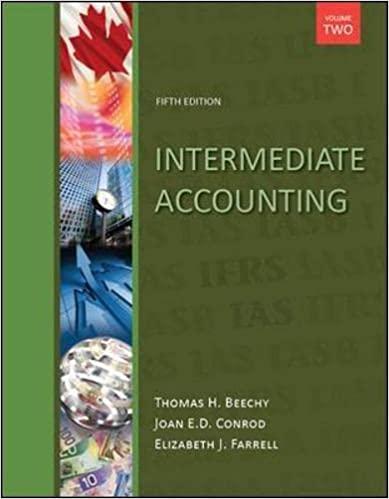Regional Airlines (RA) is a wholly owned subsidiary of National Commercial Airlines (NCA). Both companies prepare financial
Question:
Regional Airlines (RA) is a wholly owned subsidiary of National Commercial Airlines (NCA). Both companies prepare financial statements in accordance with International Financial Reporting Standards (IFRS). RA is reviewing the basis upon which it records depreciation on the fuselage of certain aircraft. There will be no change to the depreciation of all other aircraft components.
Up until the current year, RA had always depreciated aircraft fuselage on a \(4 \%\) decliningbalance basis. This was based on the belief that RA would use the aircraft for 12 years, at which time the residual value was estimated to be \(52 \%\) of the original cost. RA now recognizes that the aircraft will be used in operations for more than 12 years. Accordingly, the company will change the way it records depreciation in the current year.
The proposal is to depreciate aircraft fuselage on a straight-line basis over 20 years, with a \(20 \%\) residual value. The controller, Daniel Davison, asserted:
I know this still works out to depreciation of \(4 \%\) per year. However, we are not just changing two estimates: useful life and residual value. We are also changing the method of depreciating the fuselage. We agree with NCA's Board of Directors that the straight-line method is more relevant and reliable than declining-balance. And it makes sense for RA to use the same depreciation method as our parent company. This change in an accounting policy should be accounted for retrospectively by adjusting opening retained earnings. However, NCA's auditors are arguing that all changes should be accounted for prospectively. How can that be?
According to one international survey:
Depreciation is a prominent feature of the financial reporting in an industry that is as capital intensive as the airline industry. Estimated useful lives and residual values are subjective, and management scrutiny is essential due to the potential for technological change and development changes in the market for used aircraft and various fleet planning considerations.
This study established that the most common method of depreciation used for aircraft fuselage was straight-line. For a given aircraft classification, the estimates of useful lives ranged from 10 to 25 years and residual values ranged from zero to \(40 \%\) of cost. Airlines typically review estimated useful life annually, and 10 of 24 airlines in the survey changed their estimates within the last three years. Finally, the survey noted that material profits were reported on a number of aircraft sales by airlines included in the survey. This implied that depreciation rates generally were conservative and that book values were low when compared to market values.
Davison felt that the survey supported RA's position to depreciate more of the cost of the aircraft fuselage. Some of RA's aircraft are now in their 11 th year of use by the company. A 12 -year life did not seem realistic, since the aircraft would not be retired or sold in the next (12th) fiscal year. A change in estimated useful life was deemed necessary.
Furthermore, RA's aircraft are declining in value at a very low and somewhat steady rate. Market information suggests that these aircraft have held their market value extremely well. In addition, the standard industry price reference book, Airline Pricing Guide, included data that supported a \(4 \%\) annual decline in market value and a residual value of \(20 \%\).
Davison acknowledged that changes to estimates must be accounted for on a prospective basis, from the day of the change forward. However, he feels that this is, in essence, a change in depreciation policy and that the new method has different variables than the old method. According to Davison's calculations, a retrospective adjustment would increase depreciation in prior years by about \(\$ 1,800,000\). Net income and retained earnings would decrease. Depreciation expense for the current year will increase by \(\$ 0.2\) million.
The auditors, who issued unqualified audit reports in all prior years, argue that all depreciation changes should be dealt with on a prospective basis. Accordingly, all of the \(\$ 2.0\) million charge should appear on this year's income statement.
Davison is furious. "Our management incentives are based on income before interest and taxes. We're fine with using the same accounting method as NCA, but not if it means that we will not receive a full bonus!"
Davison would like you to provide him with a report to help him deal with the issues discussed and the arguments put forward by the auditors.
Required:
Prepare the report.
Step by Step Answer:






